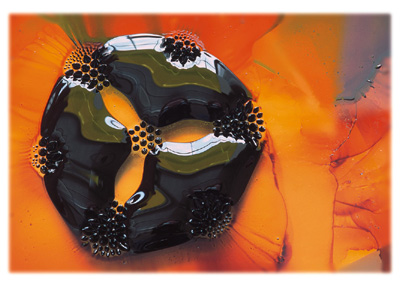![]()
Main Menu ·
Search ·
Current Issue · Contact · Archives · Centennial · Letters to the Editor · FAQs
![]()
Main Menu ·
Search ·
Current Issue · Contact · Archives · Centennial · Letters to the Editor · FAQs

|
Pity the gryphon, the mermaid, the silkie, the chimera: creatures assembled of incompatible parts, with uncertain allegiances and troubled identities. When nature calls, which nature is it? When instinct beckons, approach or flee?
A ferrofluid is a gryphon in the world of materials: part liquid, part magnet. It is prepared by grinding magnetite--the magnetic lodestone--in an oil. The grinding must be "just enough." If the particles of magnetite are too large, they remember who and what they were and behave like a fine magnetic powder, clumping and settling rapidly from the oil. If they are too small, they no longer show any of the wonderful cooperation between groups of atoms that is required for magnetism. If they are just the right size--if they are small enough that they are not so different in size and character from molecules of liquid, small enough that they have begun to lose their magnetic heritage, but still large enough that they again become fully magnetic when placed in a magnetic field--they develop a useful schizophrenia. Outside a magnetic field, they are non-magnetic liquids; in a magnetic field, they become magnetic. Grinding is carried out in the presence of soap, which coats the small particles with an oil-like surface film and makes it even more difficult to distinguish them from the oil. Properly reduced in size, and correctly coated, the particles remain dispersed and do not settle.
When placed in a magnetic field, the conflicting attractions of gravity, magnetism, and surface tension shape the ferrofluid. This drop of ferrofluid was placed on a glass sheet with yellow paper underneath for photographic contrast. Six small magnets were placed below the paper. In regions of high magnetic field, the fluid broke into spikes, trying to imitate the way iron filings line up in columns in a magnetic field. In regions of lower magnetic field it remained a liquid, forming flat drops in a compromise between the siren call of gravity and its own cautious cohesion. The result is shapes seen nowhere else in nature.
The unique properties of a ferrofluid--a stable liquid that responds to magnetic attraction--make it useful in devices where fluid properties and resistance to gravity are needed, such as rotary seals in disk drives for computers, and dampers for high-performance audio speakers.
![]()
This dish records the history of a civilization of bacteria--the few days that it lasted. The civilization started at the center, when a fresh plate of culture medium--a gel containing nutrients--was inoculated with a few bacteria. They were the first colonists. The population of the initial colony grew, and it depleted the food that was available locally.

|
The sectors follow the history of particular subgroups of these bacteria. Some families grew to the edge of the plate; less successful families were overwhelmed by the more successful, and they faded. The bacteria could not talk with one another, but they interacted by the chemicals--the "smells"--that they left, and by their influence on the local food supply and the level of pollution. When the food on their continent was exhausted, they died.
From these patterns, we infer how bacteria sense their environment. We sample our environment with different and more highly evolved senses than they do, but there are remarkable similarities between their sensors and ours. Understanding perception in all its complexity is one of the great challenges now facing biology. Evolution connects our eyes and nose to the senses of bacteria; their present is our history.
Main Menu ·
Search · Current Issue · Contact · Archives · Centennial · Letters to the Editor · FAQs
![]()